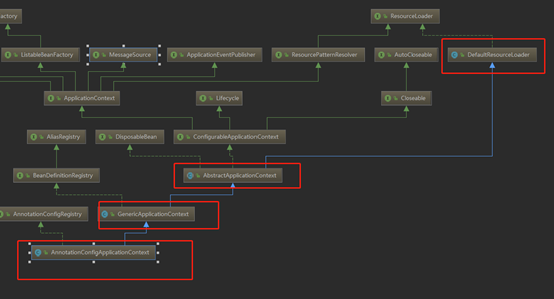1.ioc核心功能bean的配置与获取api
有以下四种
(来自精通spring4.x的p175)
常用的是前三种
第一种方式
<?xml version="1.0" encoding="GBK"?>
<beans xmlns:xsi="http://www.w3.org/2001/XMLSchema-instance"
xmlns="http://www.springframework.org/schema/beans"
xsi:schemaLocation="http://www.springframework.org/schema/beans
http://www.springframework.org/schema/beans/spring-beans-4.0.xsd">
<!-- 指定class属性,通过构造方法创建Bean实例 -->
<bean id="person" class="com.mao.gouzao.Person">
</bean>
</beans>
public static void main( String[] args )
{
ClassPathXmlApplicationContext ctx = new ClassPathXmlApplicationContext("beans.xml");
System.out.println(ctx.getBean("person"));
}
第二种方式
定义
@Service
public class UserServiceImpl {
public void test(){
System.out.println(666);
}
}
获取
@Autowired
private static UserServiceImpl userService;
第三种方式
定义
@Configuration
public class MainConfig {
@Bean
public Person person(){
return new Person();
}
}
注意: 通过@Bean的形式是使用的话,bean的默认名称是方法名,若Bean(value=“bean"的名称”)那么bean的名称是指定的
去容器中读取Bean的信息(传入配置类)
获取
public static void main( String[] args )
{
AnnotationConfigApplicationContext ctx = new AnnotationConfigApplicationContext(MainConfig.class);
System.out.println(ctx.getBean("person"));
}
2.如何实现的
1.基于Java类配置的实现方式源码分析
1.就执行了这两句代码
AnnotationConfigApplicationContext ctx = new AnnotationConfigApplicationContext(MainConfig.class);
System.out.println(ctx.getBean("person"));
先看看,打开构造器源码:
public AnnotationConfigApplicationContext(Class<?>... annotatedClasses) {
this();
register(annotatedClasses);
refresh();
}
2.首先不急,主角儿AnnotationConfigApplicationContext 它有父类,因为类初始化顺序的关系,会先初始化父类,所以得看父类,一直看到最后父类为DefaultResourceLoader
DefaultResourceLoader,很明显是用来加载资源的,倒数第二个AbstractApplicationContext的无参构造中也是初始化一个加载资源相关:
Ok,再来看最后一个父类GenericApplicationContext了,父类默认初始化使用下面这个无参的
public GenericApplicationContext() {
this.beanFactory = new DefaultListableBeanFactory();
}
这里是创建了springioc体系中的一个重要的类DefaultListableBeanFactory,DefaultListableBeanFactory非常关键里面实现了ioc相关很多功能,可以提供给我们的AnnotationConfigApplicationContext使用(后面会看到)
3.ok父类都看完了,那就回到我们的主角儿AnnotationConfigApplicationContext了
我们来看它的构造器刚刚是什么代码(回归本身):
public AnnotationConfigApplicationContext() {
this.reader = new AnnotatedBeanDefinitionReader(this);
this.scanner = new ClassPathBeanDefinitionScanner(this);
}
就两行。
4.先看第一句this.reader = new AnnotatedBeanDefinitionReader(this);
进去
public AnnotatedBeanDefinitionReader(BeanDefinitionRegistry registry) {
this(registry, getOrCreateEnvironment(registry));
}
它再次调用自己的构造器
这里还涉及了一个方法getOrCreateEnvironment(registry)
很明显这个方法从名字看就知道是有缓存的意思,获取或创建,如果是第一次则创建 第二次则就是获取了,第二次拿的第一次缓存的。如下:
private static Environment getOrCreateEnvironment(BeanDefinitionRegistry registry) {
Assert.notNull(registry, "BeanDefinitionRegistry must not be null");
if (registry instanceof EnvironmentCapable) {
return ((EnvironmentCapable) registry).getEnvironment();
}
return new StandardEnvironment();
}
ok,继续看,刚刚是从构造器到另一个构造器了:
public AnnotatedBeanDefinitionReader(BeanDefinitionRegistry registry, Environment environment) {
Assert.notNull(registry, "BeanDefinitionRegistry must not be null");
Assert.notNull(environment, "Environment must not be null");
this.registry = registry;
this.conditionEvaluator = new ConditionEvaluator(registry, environment, null);
AnnotationConfigUtils.registerAnnotationConfigProcessors(this.registry);
}
ConditionEvaluator是计算conditon的解析器(后面会讲),这里很明显主要逻辑在 AnnotationConfigUtils.registerAnnotationConfigProcessors(this.registry);
接下来AnnotationConfigUtils.registerAnnotationConfigProcessors(this.registry);是重中之重,终于开始有大段逻辑了!之前都是各种继承跳转!
registerAnnotationConfigProcessors源码实现如下
public static Set<BeanDefinitionHolder> registerAnnotationConfigProcessors(
BeanDefinitionRegistry registry, Object source) {
DefaultListableBeanFactory beanFactory = unwrapDefaultListableBeanFactory(registry);
if (beanFactory != null) {
if (!(beanFactory.getDependencyComparator() instanceof AnnotationAwareOrderComparator)) {
beanFactory.setDependencyComparator(AnnotationAwareOrderComparator.INSTANCE);
}
if (!(beanFactory.getAutowireCandidateResolver() instanceof ContextAnnotationAutowireCandidateResolver)) {
beanFactory.setAutowireCandidateResolver(new ContextAnnotationAutowireCandidateResolver());
}
}
Set<BeanDefinitionHolder> beanDefs = new LinkedHashSet<BeanDefinitionHolder>(4);
if (!registry.containsBeanDefinition(CONFIGURATION_ANNOTATION_PROCESSOR_BEAN_NAME)) {
RootBeanDefinition def = new RootBeanDefinition(ConfigurationClassPostProcessor.class);
def.setSource(source);
beanDefs.add(registerPostProcessor(registry, def, CONFIGURATION_ANNOTATION_PROCESSOR_BEAN_NAME));
}
if (!registry.containsBeanDefinition(AUTOWIRED_ANNOTATION_PROCESSOR_BEAN_NAME)) {
RootBeanDefinition def = new RootBeanDefinition(AutowiredAnnotationBeanPostProcessor.class);
def.setSource(source);
beanDefs.add(registerPostProcessor(registry, def, AUTOWIRED_ANNOTATION_PROCESSOR_BEAN_NAME));
}
if (!registry.containsBeanDefinition(REQUIRED_ANNOTATION_PROCESSOR_BEAN_NAME)) {
RootBeanDefinition def = new RootBeanDefinition(RequiredAnnotationBeanPostProcessor.class);
def.setSource(source);
beanDefs.add(registerPostProcessor(registry, def, REQUIRED_ANNOTATION_PROCESSOR_BEAN_NAME));
}
// Check for JSR-250 support, and if present add the CommonAnnotationBeanPostProcessor.
if (jsr250Present && !registry.containsBeanDefinition(COMMON_ANNOTATION_PROCESSOR_BEAN_NAME)) {
RootBeanDefinition def = new RootBeanDefinition(CommonAnnotationBeanPostProcessor.class);
def.setSource(source);
beanDefs.add(registerPostProcessor(registry, def, COMMON_ANNOTATION_PROCESSOR_BEAN_NAME));
}
// Check for JPA support, and if present add the PersistenceAnnotationBeanPostProcessor.
if (jpaPresent && !registry.containsBeanDefinition(PERSISTENCE_ANNOTATION_PROCESSOR_BEAN_NAME)) {
RootBeanDefinition def = new RootBeanDefinition();
try {
def.setBeanClass(ClassUtils.forName(PERSISTENCE_ANNOTATION_PROCESSOR_CLASS_NAME,
AnnotationConfigUtils.class.getClassLoader()));
}
catch (ClassNotFoundException ex) {
throw new IllegalStateException(
"Cannot load optional framework class: " + PERSISTENCE_ANNOTATION_PROCESSOR_CLASS_NAME, ex);
}
def.setSource(source);
beanDefs.add(registerPostProcessor(registry, def, PERSISTENCE_ANNOTATION_PROCESSOR_BEAN_NAME));
}
if (!registry.containsBeanDefinition(EVENT_LISTENER_PROCESSOR_BEAN_NAME)) {
RootBeanDefinition def = new RootBeanDefinition(EventListenerMethodProcessor.class);
def.setSource(source);
beanDefs.add(registerPostProcessor(registry, def, EVENT_LISTENER_PROCESSOR_BEAN_NAME));
}
if (!registry.containsBeanDefinition(EVENT_LISTENER_FACTORY_BEAN_NAME)) {
RootBeanDefinition def = new RootBeanDefinition(DefaultEventListenerFactory.class);
def.setSource(source);
beanDefs.add(registerPostProcessor(registry, def, EVENT_LISTENER_FACTORY_BEAN_NAME));
}
return beanDefs;
}
挺长,先看第一部分:
DefaultListableBeanFactory beanFactory = unwrapDefaultListableBeanFactory(registry);
if (beanFactory != null) {
if (!(beanFactory.getDependencyComparator() instanceof AnnotationAwareOrderComparator)) {
beanFactory.setDependencyComparator(AnnotationAwareOrderComparator.INSTANCE);
}
if (!(beanFactory.getAutowireCandidateResolver() instanceof ContextAnnotationAutowireCandidateResolver)) {
beanFactory.setAutowireCandidateResolver(new ContextAnnotationAutowireCandidateResolver());
}
}
很明显这是从registry里拿DefaultListableBeanFactory ,还记得前面讲主角儿AnnotationConfigApplicationContext的父类GenericApplicationContext吗?在它的无参构造中就创建了DefaultListableBeanFactory。现在到这个registry里去拿,而这个registry就是前面用this传过来的主角儿AnnotationConfigApplicationContext自然就有DefaultListableBeanFactory了。后面的逻辑就是null判断和设置比较器和解析器到里面了。
Set<BeanDefinitionHolder> beanDefs = new LinkedHashSet<BeanDefinitionHolder>(4);
if (!registry.containsBeanDefinition(CONFIGURATION_ANNOTATION_PROCESSOR_BEAN_NAME)) {
RootBeanDefinition def = new RootBeanDefinition(ConfigurationClassPostProcessor.class);
def.setSource(source);
beanDefs.add(registerPostProcessor(registry, def, CONFIGURATION_ANNOTATION_PROCESSOR_BEAN_NAME));
}
if (!registry.containsBeanDefinition(AUTOWIRED_ANNOTATION_PROCESSOR_BEAN_NAME)) {
RootBeanDefinition def = new RootBeanDefinition(AutowiredAnnotationBeanPostProcessor.class);
def.setSource(source);
beanDefs.add(registerPostProcessor(registry, def, AUTOWIRED_ANNOTATION_PROCESSOR_BEAN_NAME));
}
if (!registry.containsBeanDefinition(REQUIRED_ANNOTATION_PROCESSOR_BEAN_NAME)) {
RootBeanDefinition def = new RootBeanDefinition(RequiredAnnotationBeanPostProcessor.class);
def.setSource(source);
beanDefs.add(registerPostProcessor(registry, def, REQUIRED_ANNOTATION_PROCESSOR_BEAN_NAME));
}
// Check for JSR-250 support, and if present add the CommonAnnotationBeanPostProcessor.
if (jsr250Present && !registry.containsBeanDefinition(COMMON_ANNOTATION_PROCESSOR_BEAN_NAME)) {
RootBeanDefinition def = new RootBeanDefinition(CommonAnnotationBeanPostProcessor.class);
def.setSource(source);
beanDefs.add(registerPostProcessor(registry, def, COMMON_ANNOTATION_PROCESSOR_BEAN_NAME));
}
// Check for JPA support, and if present add the PersistenceAnnotationBeanPostProcessor.
if (jpaPresent && !registry.containsBeanDefinition(PERSISTENCE_ANNOTATION_PROCESSOR_BEAN_NAME)) {
RootBeanDefinition def = new RootBeanDefinition();
try {
def.setBeanClass(ClassUtils.forName(PERSISTENCE_ANNOTATION_PROCESSOR_CLASS_NAME,
AnnotationConfigUtils.class.getClassLoader()));
}
catch (ClassNotFoundException ex) {
throw new IllegalStateException(
"Cannot load optional framework class: " + PERSISTENCE_ANNOTATION_PROCESSOR_CLASS_NAME, ex);
}
def.setSource(source);
beanDefs.add(registerPostProcessor(registry, def, PERSISTENCE_ANNOTATION_PROCESSOR_BEAN_NAME));
}
if (!registry.containsBeanDefinition(EVENT_LISTENER_PROCESSOR_BEAN_NAME)) {
RootBeanDefinition def = new RootBeanDefinition(EventListenerMethodProcessor.class);
def.setSource(source);
beanDefs.add(registerPostProcessor(registry, def, EVENT_LISTENER_PROCESSOR_BEAN_NAME));
}
if (!registry.containsBeanDefinition(EVENT_LISTENER_FACTORY_BEAN_NAME)) {
RootBeanDefinition def = new RootBeanDefinition(DefaultEventListenerFactory.class);
def.setSource(source);
beanDefs.add(registerPostProcessor(registry, def, EVENT_LISTENER_FACTORY_BEAN_NAME));
}
return beanDefs;
创建了一个set集合保存BeanDefinitionHolder(BeanDefinition是)。后面就非常多的if判断。这都是判断啥呢?
if (!registry.containsBeanDefinition(CONFIGURATION_ANNOTATION_PROCESSOR_BEAN_NAME)) {
RootBeanDefinition def = new RootBeanDefinition(ConfigurationClassPostProcessor.class);
def.setSource(source);
beanDefs.add(registerPostProcessor(registry, def, CONFIGURATION_ANNOTATION_PROCESSOR_BEAN_NAME));
}
判断registry中是否存在一个个的常量定义的东西。那这些常量是什么呢?打开一看:
public static final String CONFIGURATION_ANNOTATION_PROCESSOR_BEAN_NAME = "org.springframework.context.annotation.internalConfigurationAnnotationProcessor";
是个类的全路径,如果registry里面没有就执行最后一句(前两句都是给最后一句服务的):
beanDefs.add(registerPostProcessor(registry, def, CONFIGURATION_ANNOTATION_PROCESSOR_BEAN_NAME));
也就是判断有没有这个类,没有就添加这个类进去,这这个类是用来解析配置注解的处理器。
还有个 public static final String AUTOWIRED_ANNOTATION_PROCESSOR_BEAN_NAME = “org.springframework.context.annotation.internalAutowiredAnnotationProcessor”;
综合所见,这段代码后半部分其实就是注册spring支持的各种注解的解析器的逻辑
这个对应是用来解析自动装配注解的
最后如下:
public static Set<BeanDefinitionHolder> registerAnnotationConfigProcessors(
BeanDefinitionRegistry registry, Object source) {
//获取之前创建的DefaultListableBeanFactory,检查null并塞入相关组件
DefaultListableBeanFactory beanFactory = unwrapDefaultListableBeanFactory(registry);
if (beanFactory != null) {
if (!(beanFactory.getDependencyComparator() instanceof AnnotationAwareOrderComparator)) {
beanFactory.setDependencyComparator(AnnotationAwareOrderComparator.INSTANCE);
}
if (!(beanFactory.getAutowireCandidateResolver() instanceof ContextAnnotationAutowireCandidateResolver)) {
beanFactory.setAutowireCandidateResolver(new ContextAnnotationAutowireCandidateResolver());
}
}
Set<BeanDefinitionHolder> beanDefs = new LinkedHashSet<BeanDefinitionHolder>(8);
//注册一个配置类@Configuration解析器的bean定义(ConfigurationClassPostProcessor)
if (!registry.containsBeanDefinition(CONFIGURATION_ANNOTATION_PROCESSOR_BEAN_NAME)) {
RootBeanDefinition def = new RootBeanDefinition(ConfigurationClassPostProcessor.class);
def.setSource(source);
beanDefs.add(registerPostProcessor(registry, def, CONFIGURATION_ANNOTATION_PROCESSOR_BEAN_NAME));
}
//设置AutoWired注解解析器的bean定义信息
if (!registry.containsBeanDefinition(AUTOWIRED_ANNOTATION_PROCESSOR_BEAN_NAME)) {
RootBeanDefinition def = new RootBeanDefinition(AutowiredAnnotationBeanPostProcessor.class);
def.setSource(source);
beanDefs.add(registerPostProcessor(registry, def, AUTOWIRED_ANNOTATION_PROCESSOR_BEAN_NAME));
}
//注册解析@Required 注解的处理器
if (!registry.containsBeanDefinition(REQUIRED_ANNOTATION_PROCESSOR_BEAN_NAME)) {
RootBeanDefinition def = new RootBeanDefinition(RequiredAnnotationBeanPostProcessor.class);
def.setSource(source);
beanDefs.add(registerPostProcessor(registry, def, REQUIRED_ANNOTATION_PROCESSOR_BEAN_NAME));
}
//检查是否支持JSR250规范,如何支持注册 解析JSR250规范的注解
// Check for JSR-250 support, and if present add the CommonAnnotationBeanPostProcessor.
if (jsr250Present && !registry.containsBeanDefinition(COMMON_ANNOTATION_PROCESSOR_BEAN_NAME)) {
RootBeanDefinition def = new RootBeanDefinition(CommonAnnotationBeanPostProcessor.class);
def.setSource(source);
beanDefs.add(registerPostProcessor(registry, def, COMMON_ANNOTATION_PROCESSOR_BEAN_NAME));
}
//检查是否支持jpa,若支持注册解析jpa规范的注解
// Check for JPA support, and if present add the PersistenceAnnotationBeanPostProcessor.
if (jpaPresent && !registry.containsBeanDefinition(PERSISTENCE_ANNOTATION_PROCESSOR_BEAN_NAME)) {
RootBeanDefinition def = new RootBeanDefinition();
try {
def.setBeanClass(ClassUtils.forName(PERSISTENCE_ANNOTATION_PROCESSOR_CLASS_NAME,
AnnotationConfigUtils.class.getClassLoader()));
}
catch (ClassNotFoundException ex) {
throw new IllegalStateException(
"Cannot load optional framework class: " + PERSISTENCE_ANNOTATION_PROCESSOR_CLASS_NAME, ex);
}
def.setSource(source);
beanDefs.add(registerPostProcessor(registry, def, PERSISTENCE_ANNOTATION_PROCESSOR_BEAN_NAME));
}
//注册解析@EventListener的注解解析器
if (!registry.containsBeanDefinition(EVENT_LISTENER_PROCESSOR_BEAN_NAME)) {
RootBeanDefinition def = new RootBeanDefinition(EventListenerMethodProcessor.class);
def.setSource(source);
beanDefs.add(registerPostProcessor(registry, def, EVENT_LISTENER_PROCESSOR_BEAN_NAME));
}
if (!registry.containsBeanDefinition(EVENT_LISTENER_FACTORY_BEAN_NAME)) {
RootBeanDefinition def = new RootBeanDefinition(DefaultEventListenerFactory.class);
def.setSource(source);
beanDefs.add(registerPostProcessor(registry, def, EVENT_LISTENER_FACTORY_BEAN_NAME));
}
//最后带着这一堆spring支持的功能的解析器返回(实际上刚刚分析的过程中压根没用到这个返回值,那是为什么呢?值得注意的是 原来它是把这些搞到registry里去了,综上, 注入这堆注解解析器 到registry 也就是DefaultListableBeanFactory中!)
return beanDefs;
}
好,以上这部分分析结束,回到主角儿AnnotationConfigApplicationContext,之前我们是从它的构造器:
public AnnotationConfigApplicationContext() {
this.reader = new AnnotatedBeanDefinitionReader(this);
this.scanner = new ClassPathBeanDefinitionScanner(this);
}
中分析的第一句终于把这个reader完毕了,接下来分析第二句咯。
名字可以看出是类路径下的扫描器,开始查看源码!
public ClassPathBeanDefinitionScanner(BeanDefinitionRegistry registry) {
this(registry, true);
}
继续跟进
public ClassPathBeanDefinitionScanner(BeanDefinitionRegistry registry, boolean useDefaultFilters) {
this(registry, useDefaultFilters, getOrCreateEnvironment(registry));
}
第一个registry 还是之前说的DefaultListableBeanFactory传的this,第二个也就是 传了个true,是否使用默认的filter,选择了是。第三个之前讲过了,有则用没有则创建,缓存。继续跟
public ClassPathBeanDefinitionScanner(BeanDefinitionRegistry registry, boolean useDefaultFilters,
Environment environment, ResourceLoader resourceLoader) {
Assert.notNull(registry, "BeanDefinitionRegistry must not be null");
this.registry = registry;
if (useDefaultFilters) {
registerDefaultFilters();
}
setEnvironment(environment);
setResourceLoader(resourceLoader);
}
这部分代码前面就是赋值、注册默认的filters、设置从registry拿的环境设置、最后设置ResourceLoader
一部分一部分的看,先看registerDefaultFilters();
/**
* Register the default filter for {@link Component @Component}.
* <p>This will implicitly register all annotations that have the
* {@link Component @Component} meta-annotation including the
* {@link Repository @Repository}, {@link Service @Service}, and
* {@link Controller @Controller} stereotype annotations.
* <p>Also supports Java EE 6's {@link javax.annotation.ManagedBean} and
* JSR-330's {@link javax.inject.Named} annotations, if available.
*
*/
@SuppressWarnings("unchecked")
protected void registerDefaultFilters() {
this.includeFilters.add(new AnnotationTypeFilter(Component.class));
ClassLoader cl = ClassPathScanningCandidateComponentProvider.class.getClassLoader();
try {
this.includeFilters.add(new AnnotationTypeFilter(
((Class<? extends Annotation>) ClassUtils.forName("javax.annotation.ManagedBean", cl)), false));
logger.debug("JSR-250 'javax.annotation.ManagedBean' found and supported for component scanning");
}
catch (ClassNotFoundException ex) {
// JSR-250 1.1 API (as included in Java EE 6) not available - simply skip.
}
try {
this.includeFilters.add(new AnnotationTypeFilter(
((Class<? extends Annotation>) ClassUtils.forName("javax.inject.Named", cl)), false));
logger.debug("JSR-330 'javax.inject.Named' annotation found and supported for component scanning");
}
catch (ClassNotFoundException ex) {
// JSR-330 API not available - simply skip.
}
}
方法注释可以看到 意思是,注册这些默认的filter,@Component、@Repository、@Controller才会起作用
然后方法内部就注入添加Component.class进去了,让@Component起作用,而@Repository、@Controller本身都被打了@Component 是子注解,所以也连带起作用
后面部分就是判断jsr250 330相关注解了
到此看完了,回到上层上层去,至此
public AnnotationConfigApplicationContext(DefaultListableBeanFactory beanFactory) {
super(beanFactory);
this.reader = new AnnotatedBeanDefinitionReader(this);
this.scanner = new ClassPathBeanDefinitionScanner(this);
}
中的第二句我们也大致看完了,至此一个构造器看完了。大功告成…了,一半。。。发现这个构造器是无参的,而我们之前用的两句代码:
AnnotationConfigApplicationContext annotationConfigApplication = new AnnotationConfigApplicationContext (MainConfig.class);Person person2 = (Person)annotationConfigApplication.getBean("person2");
中主角AnnotationConfigApplicationContext用的带class的构造器啊,看来没完,原来这个构造器还有上层调用,在这:
public AnnotationConfigApplicationContext(Class<?>... annotatedClasses) {
this();
register(annotatedClasses);
refresh();
}
这里才是最开始那两行代码的第一次调用处。我们把this();看完了!
接下来看第二句register(annotatedClasses);,不断跟进
public void register(Class<?>... annotatedClasses) {
Assert.notEmpty(annotatedClasses, "At least one annotated class must be specified");
this.reader.register(annotatedClasses);
}
不断跟进到这
public void registerBean(Class<?> annotatedClass, String name, Class<? extends Annotation>... qualifiers) {
AnnotatedGenericBeanDefinition abd = new AnnotatedGenericBeanDefinition(annotatedClass);
if (this.conditionEvaluator.shouldSkip(abd.getMetadata())) {
return;
}
ScopeMetadata scopeMetadata = this.scopeMetadataResolver.resolveScopeMetadata(abd);
abd.setScope(scopeMetadata.getScopeName());
String beanName = (name != null ? name : this.beanNameGenerator.generateBeanName(abd, this.registry));
AnnotationConfigUtils.processCommonDefinitionAnnotations(abd);
if (qualifiers != null) {
for (Class<? extends Annotation> qualifier : qualifiers) {
if (Primary.class == qualifier) {
abd.setPrimary(true);
}
else if (Lazy.class == qualifier) {
abd.setLazyInit(true);
}
else {
abd.addQualifier(new AutowireCandidateQualifier(qualifier));
}
}
}
BeanDefinitionHolder definitionHolder = new BeanDefinitionHolder(abd, beanName);
definitionHolder = AnnotationConfigUtils.applyScopedProxyMode(scopeMetadata, definitionHolder, this.registry);
BeanDefinitionReaderUtils.registerBeanDefinition(definitionHolder, this.registry);
}
原来这句代码是把传入的配置类里的bean全给注册了。至此第二句完毕。至于最后第三句核心,留给下篇文章。一起加油!
共同学习,写下你的评论
评论加载中...
作者其他优质文章






